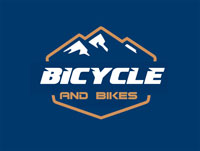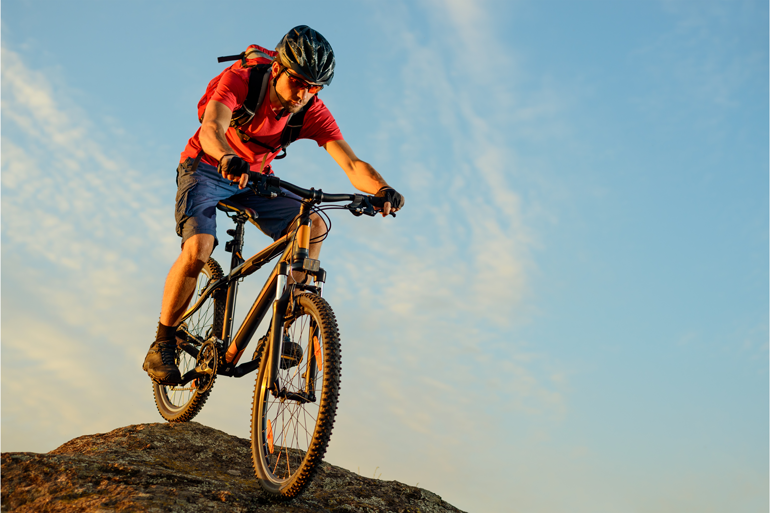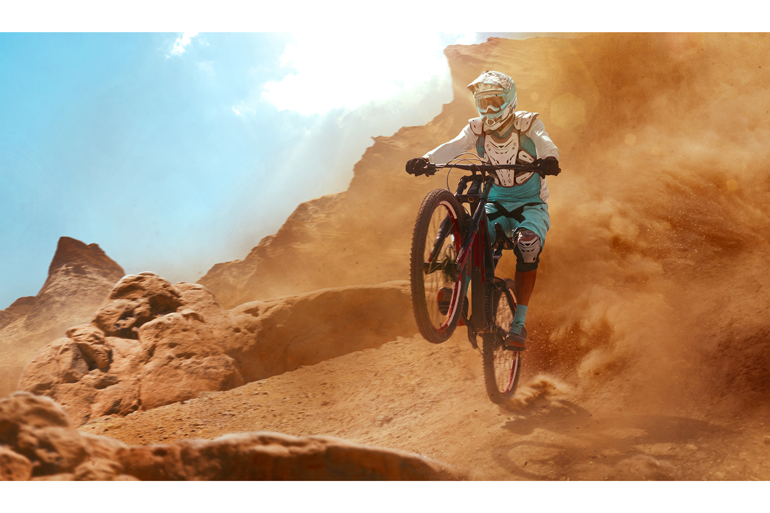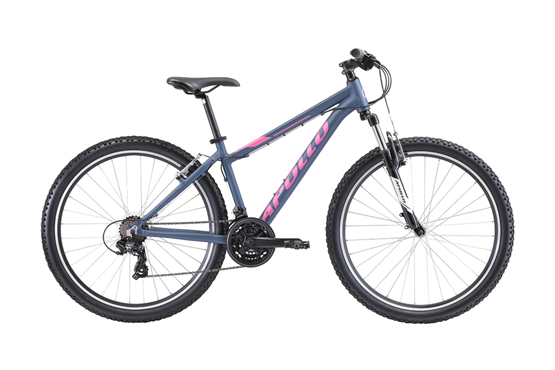Mountain Bike
Also Known As
‘MTB’ or ‘All-Terrain Bike’ or ‘ATB’
The Mighty Mountain Bike
A mountain bike takes a pounding over all the rough terrain that you cover, so their frames need to be strong – and capable of withstanding hard, steep hill climbs.
They also need lots of space for mud and rock clearance … and let’s not forget a great suspension system so that your teeth don’t rattle on some of the more rough and hair-raising downhill trails!
When you tackle those downhill mountain trails you are going to need a bicycle that has … lots of gears, knobbly fat tires – to give the wheels good grip, suspension forks – to soften the bumps, terrific brakes, rear suspension and strong straight handlebars for maneuvering your MTB.
On this page you will terrific information on…
Different Types of Mountain Bikes
There are many different classifications of Mountain bikes and they include:
- Downhill
- Cross Country
- Recreational
- Trail
- Slopestyle
- Fatbike
- Electric
- Hardtail
- Freeride
- Enduro / All Mountain Bike
- Dirt Jumping
- Recumbent
- Folding
- MTB Trike
Suspension Styles
The Different MTB Disciplines
Features To Look For When Buying a Mountain Bike
Manufacturers of Mountain Bike
Types of Mountain Bikes
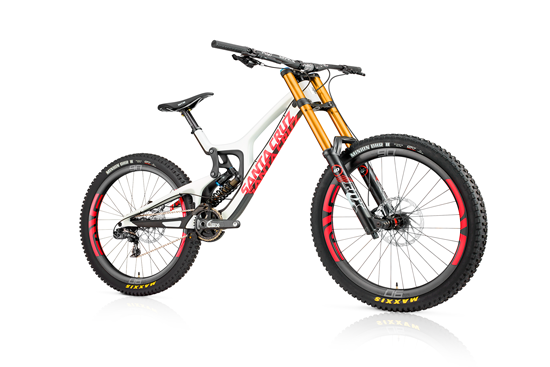 Downhill (DH) Mountain Bike
Downhill (DH) Mountain Bike
Downhill mountain bikes are purpose-built for extreme downhill racing and aggressive terrains.
They come with full suspension, slack geometry, wide knobby tires, powerful brakes, and robust frames to handle high speeds and rough trails.
The long-travel suspension, usually around 200mm-220mm, ensures the bike can absorb large impacts and drops with ease, providing a smooth ride even on the most challenging descents.
The slack head tube angle and low bottom bracket position enhance stability and control, allowing riders to confidently navigate steep and technical sections.
With powerful hydraulic disc brakes, fewer gears often paired with a chain guide, and components built for extreme durability, these bikes are built to withstand the rigors of downhill racing.
Downhill MTBs often have larger brake rotors for improved stopping power, ensuring precise control when navigating through tight turns and obstacles.
Despite their heavier weight, their performance on steep, rocky terrains is unmatched. With downhill-specific components and features, these bikes are the ultimate choice for thrill-seekers and adrenaline junkies looking to conquer the most demanding descents with confidence and style.
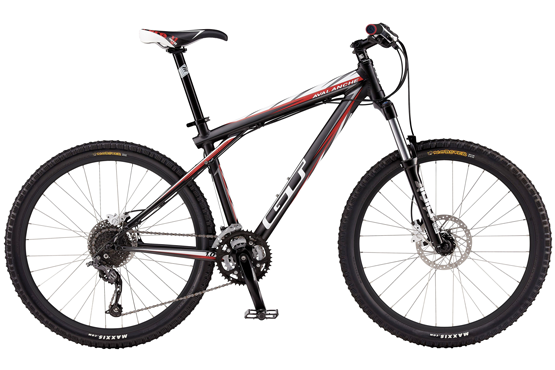 Cross-Country (XC) Mountain Bike
Cross-Country (XC) Mountain Bike
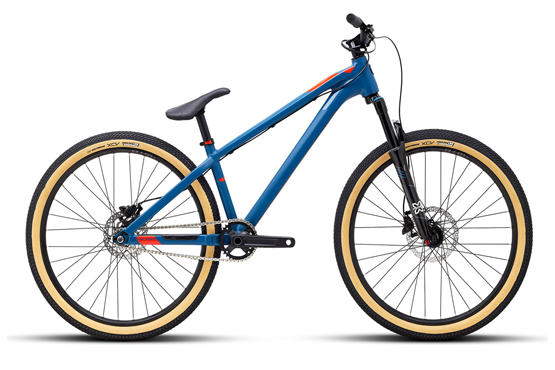 Dirt Jump (DJ) Mountain Bike
Dirt Jump (DJ) Mountain Bike
Dirt Jump mountain bikes are primarily designed for dirt jumps and street riding.
They have a robust and lightweight hardtail frame,with a front suspension fork , built to withstand the demands of aerial maneuvers and hard landings.
Dirt Jump bicycles typically feature a shorter wheelbase, responsive geometry, and a rigid or short-travel suspension fork for maximum maneuverability and precise handling in the air.
They often come with smaller, 24-26 inch wheels and lower seat heights to provide better maneuverability and control.
Dirt jump bikes come with strong and durable components to handle the rigors of repeated jumps and tricks.
The compact frame allows riders to easily manipulate the bike in the air, while the wide handlebars provide better control during tricks and stunts.
With their BMX-inspired design and durable construction, dirt jump mountain bikes are the perfect choice for riders seeking to showcase their skills in the world of aerial acrobatics and gravity-defying stunts.
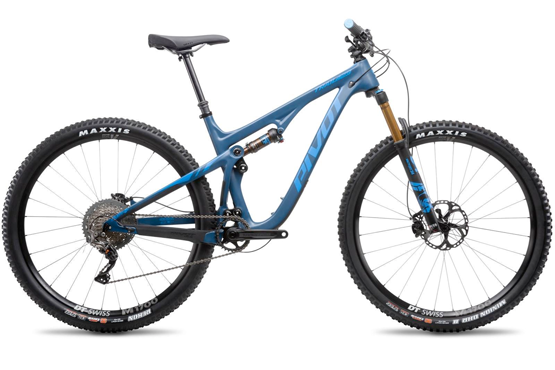 MTB Trail Bikes
MTB Trail Bikes
These are the most common type of mountain bike.
Trail bikes are designed to handle a wide variety of terrains and conditions, from smooth single tracks to rough and rocky trails.
These versatile bikes feature a balanced mix of durability, comfort, and performance to provide a smooth and enjoyable riding experience on singletrack trails, rocky paths, and technical descents.
They often have more suspension travel than cross-country bikes, usually between 120mm and 150mm, and more relaxed geometry to provide stability on descents.
The full-suspension system absorbs any impacts and improves traction, making them ideal for challenging terrains.
Trail bicycles have medium-width tires with aggressive tread patterns for better grip and control on loose or uneven surfaces.
The frame geometry is optimized for stability and maneuverability, allowing riders to navigate tight corners and technical sections with ease.
Equipped with a wide range of gears, strong brakes, and reliable components, MTB trail bikes offer the perfect blend of efficiency and versatility, making them the go-to choice for riders who love exploring the great outdoors and conquering new trails with confidence.
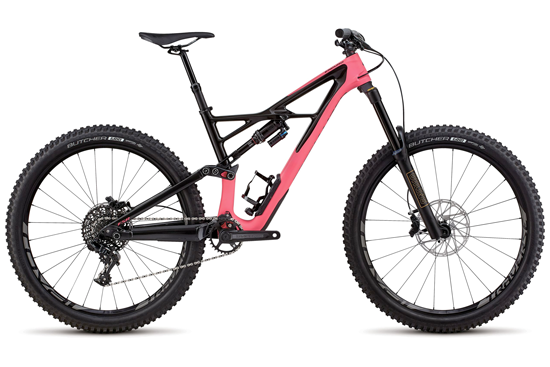 Enduro/All-Mountain Bikes
Enduro/All-Mountain Bikes
Enduro/All-mountain mountain bikes are designed to excel in challenging and varied terrains, making them a favorite among adventurous riders seeking thrilling descents and rewarding climbs.
These bikes strike a perfect balance between downhill performance and efficient climbing capabilities, allowing riders to conquer both technical descents and steep uphills with ease.
Enduro bikes typically feature a full-suspension system with ample travel to absorb rough impacts and maintain stability on rocky trails. They have more suspension travel than trail bikes, usually between 140mm and 170mm, and more aggressive geometry.
The frame geometry is optimized for stability and control, while still being nimble enough for agile maneuvers.
These bikes often come with wide tires with aggressive tread patterns for superior grip and traction on diverse surfaces.
With a wide gear range, powerful brakes, and durable components, Enduro/All-mountain mountain bikes are the perfect companions for those seeking adrenaline-pumping adventures and the freedom to explore new trails and conquer rugged terrain.
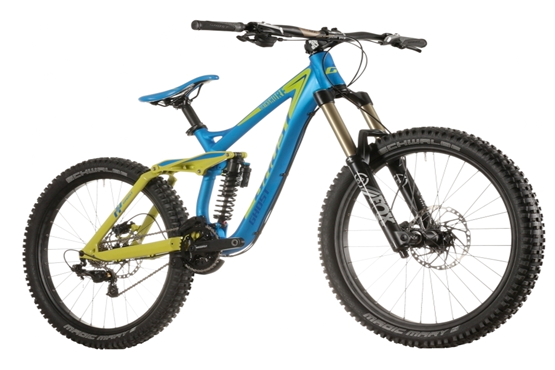 Freeride Mountain Bike
Freeride Mountain Bike
Freeride mountain bikes are designed for the thrill-seekers and adrenaline junkies who love pushing the limits of gravity and taking on extreme terrain.
These bikes are built to withstand the harshest riding conditions and are perfect for riders who enjoy hitting big jumps, drops, stunts, and technical features in bike parks and challenging trails.
Freeride bikes typically have robust frames with extra reinforcements to handle the heavy impact of jumps and stunts.
They feature long-travel suspension forks and rear shocks to provide maximum cushioning and control when landing jumps and tackling rough descents. They feature a high amount of suspension travel and are built tough to withstand hard landings, but are not meant for long distance riding or climbing.
The wide and knobby tires ensure excellent traction and stability on a variety of surfaces.
With strong and reliable disc brakes, freeride mountain bikes offer precise stopping power and control during high-speed descents. These bikes are the ultimate choice for riders who crave the thrill of gravity-defying tricks and seek the rush of conquering daring lines on the mountain.
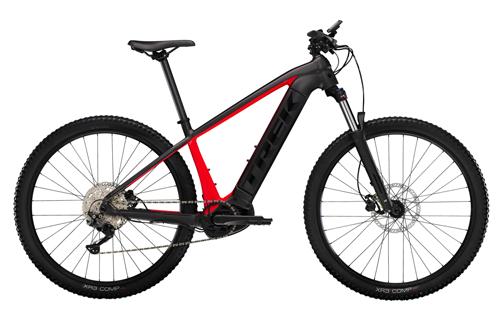 Hardtail Mountain Bike
Hardtail Mountain Bike
Hardtail mountain bikes are known for their simplicity and versatility.
Unlike full-suspension bikes, hardtails feature a suspension fork at the front to absorb impacts and provide a smoother ride over rough terrain, but they lack a rear suspension.
The absence of rear suspension means that hardtails have a lighter and more efficient frame, making them excellent climbers and well-suited for cross-country riding.
Their rigid rear end also transfers power more directly to the pedals, offering a more efficient pedaling experience.
Hardtails are popular among riders who enjoy cross-country racing, trail riding, and climbing challenging ascents.
With their nimble and responsive handling, hardtails provide an engaging ride on smoother trails and offer an ideal option for riders seeking an affordable and low-maintenance mountain biking experience.
However, on rough and technical descents, they may not be as comfortable or forgiving as their full-suspension counterparts.
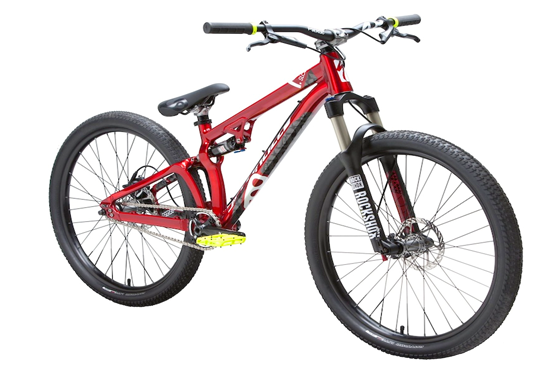 Slopestyle Mountain Bike
Slopestyle Mountain Bike
Slopestyle bikes are purpose-built for the adrenaline-pumping sport of slopestyle riding, where riders perform daring tricks and jumps on specially designed courses.
These specialty courses feature large jumps, drops, and built features like wallrides and obstacles.
Slopestyle bikes feature full suspension with both front and rear shocks to handle the impact of big drops, while maintaining control and responsiveness.
Their robust frames and components are built to withstand the high-impact landings and intense maneuvers involved in slopestyle riding.
With short wheelbases and slack head angles, these bikes offer agility and stability for quick direction changes and aerial stunts.
Wider handlebars and grippy tires enhance rider control during high-flying tricks. Slopestyle bikes empower riders to push their limits and amaze audiences with gravity-defying feats in this thrilling discipline.
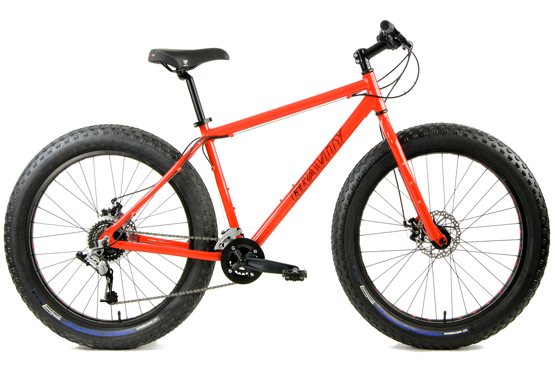 Fat Bikes
Fat Bikes
Fat tire mountain bikes, also known as fat bikes, are designed for riding on soft, unstable terrains such as snow, sand, mud, and loose dirt.
Fat bikes are a type of mountain bike that features oversized tires typically 3.8 in (97 mm) or larger and rims 2.16 in (55 mm) or wider designed for low ground pressure to allow riding on soft, unstable terrain such as snow, sand, bogs and mud.
The wide tires and rims allow fat bikes to float over challenging surfaces, providing excellent traction and stability.
The frames of fat tire mountain bikes are built to accommodate these large tires and often have extra clearance to prevent mud and snow buildup.
Fat bikes come with either full suspension or rigid frames, and some models may have front suspension forks to further enhance comfort and control on rough terrains.
These versatile bikes are excellent for exploring rugged trails, enjoying year-round cycling, and providing a fun and adventurous riding experience.
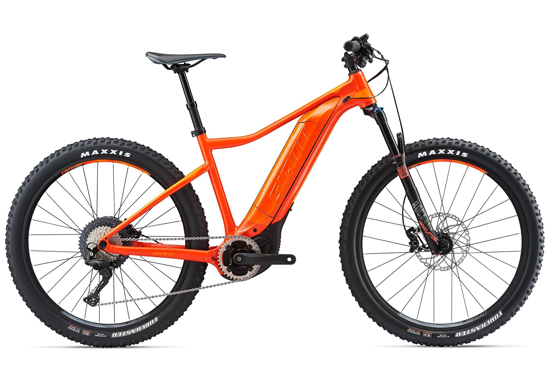 Electric Mountain Bike
Electric Mountain Bike
An electric mountain bike, often referred to as an eMTB or electric MTB, is a revolutionary fusion of cutting-edge technology and the ruggedness of a traditional mountain bike.
These bikes are equipped with an electric motor and a battery that provide pedal-assistance or full electric power to complement the rider’s efforts.
The electric motor on an eMTB can be activated through various power modes, allowing riders to choose the level of assistance they desire.
This feature proves particularly useful during challenging hill climbs or when tackling long distances, as the motor helps reduce physical strain and fatigue.
eMTBs come with specially designed frames and components to accommodate the additional weight of the electric motor and battery.
Despite the added technology, they still retain the durability and sturdiness required for off-road adventures.
Many eMTBs have robust suspension systems, wide and grippy tires, and strong braking capabilities, ensuring they can handle the demanding conditions of mountain biking.
Recreational Mountain Bikes
These MTBs are designed for casual riders who enjoy cycling in their leisure time on less demanding terrains such as parks, local trails, or neighborhood paths.
Recreational mountain bikes are versatile and user-friendly, offering a comfortable riding position.
They may not have the technical features or rugged construction of more advanced mountain bikes but are perfect for those who want to enjoy the benefits of outdoor cycling without racing or tackling very rough terrains.
Recumbent Mountain Bikes
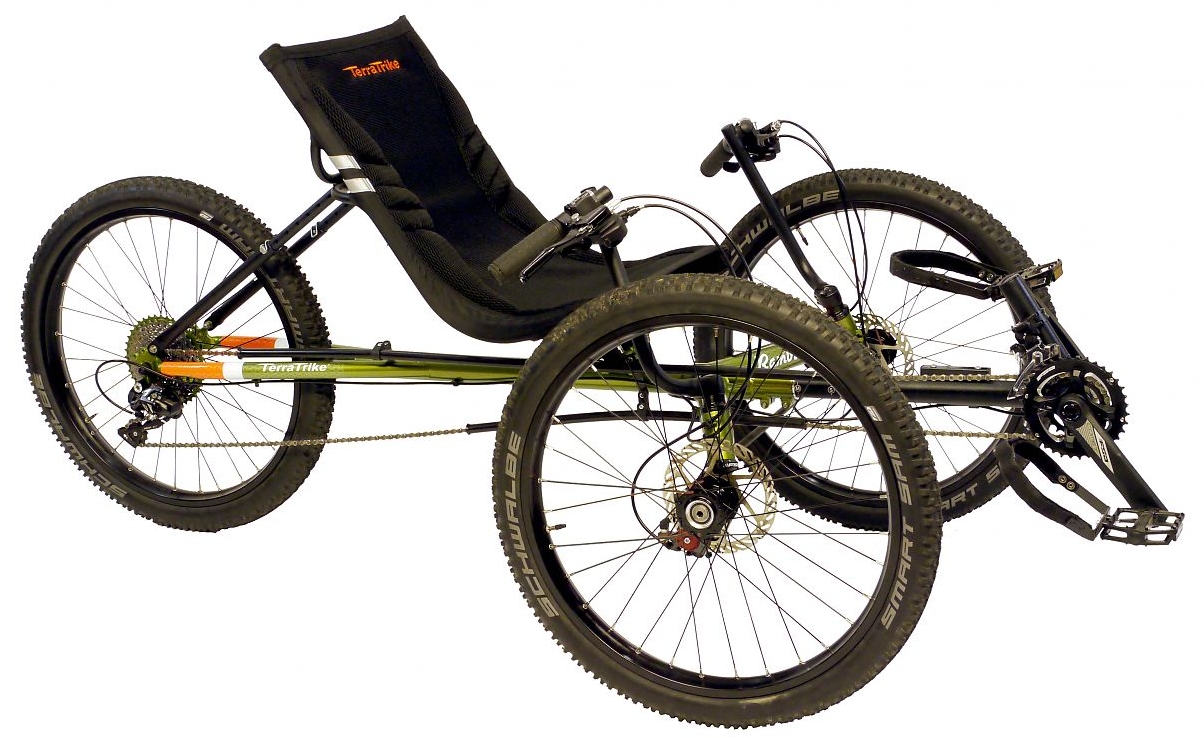 Recumbent mountain bikes are a fascinating blend of comfort and versatility, catering to adventure seekers who crave the thrill of off-road exploration in a relaxed riding position.
Recumbent mountain bikes are a fascinating blend of comfort and versatility, catering to adventure seekers who crave the thrill of off-road exploration in a relaxed riding position.
These recumbent bikes boast a sturdy frame, specifically designed to withstand the rugged terrains they are meant to conquer.
What sets them apart are their oversized tires, typically 3.8 inches (97 mm) or larger, and wider rims with around 2.16 inches (55 mm) clearance.
This robust tire configuration allows for low ground pressure, making it ideal for navigating soft, unstable surfaces like snow, sand, bogs, and mud.
With their wide fork clearance and suspension system, recumbent mountain bikes effortlessly glide over bumps and rocks, providing a smooth and exhilarating ride.
Folding Mountain Bikes
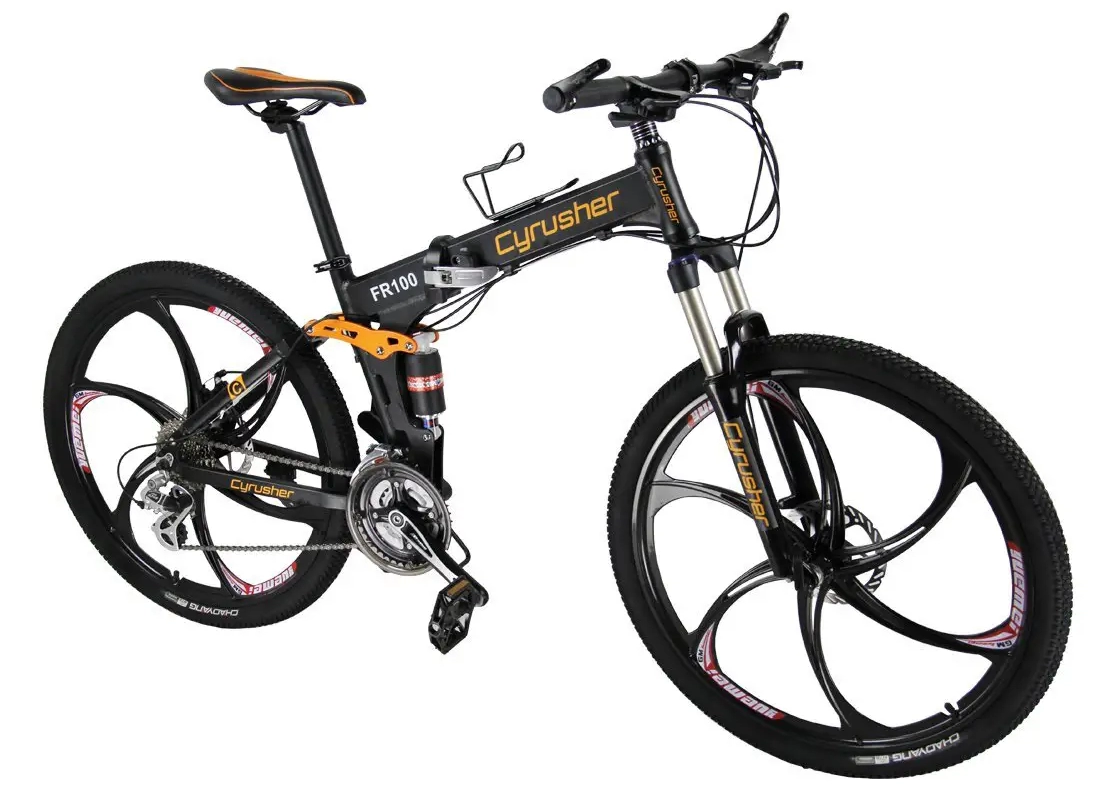 Folding mountain bikes combine the convenience of portability with the rugged capabilities of a mountain bike.
Folding mountain bikes combine the convenience of portability with the rugged capabilities of a mountain bike.
These versatile bicycles feature a collapsible frame, allowing riders to fold and unfold them quickly and easily. The folding mechanism is designed to maintain the bike’s structural integrity while providing a compact form for effortless storage and transportation.
These bikes typically come with robust frames and durable components, ensuring they can handle the challenges of off-road trails.
While their wheel size and tire width may vary, they are often equipped with knobby tires to ensure traction on various terrains.
Folding mountain bikes also feature suspension systems, providing riders with a smoother ride on uneven and bumpy surfaces.
The folding feature makes these bikes perfect for commuters who want to combine cycling with public transportation or for travelers who desire an adventurous experience in different locations.
Mountain Trikes
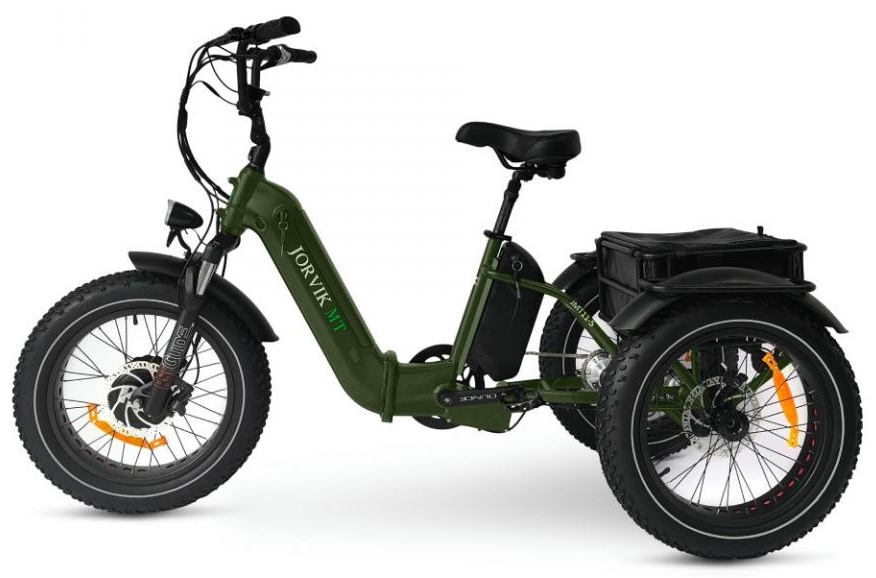 A trike mountain bike, also known as a mountain trike, is a unique and specialized type of mountain bike that features three wheels instead of the traditional two.
A trike mountain bike, also known as a mountain trike, is a unique and specialized type of mountain bike that features three wheels instead of the traditional two.
This innovative design provides enhanced stability and balance, making it an excellent choice for riders who may have difficulty balancing on a regular mountain bike or those seeking a different cycling experience.
Trike mountain bikes come with rugged frames and durable components, ensuring they can handle the rough and challenging terrains encountered during off-road adventures.
The three-wheel configuration offers increased traction, allowing riders to confidently tackle loose and uneven surfaces.
Additionally, the wider stance of the trike provides excellent stability, making it easier to navigate through tight and technical sections of the trail.
These bikes often come equipped with suspension systems, ensuring a smoother ride and improved handling over rough terrain.
With their exceptional stability and comfortable design, trike mountain bikes are a fantastic option for riders of all abilities, including those who may have mobility challenges.
Suspension Styles
There are generally four different types of suspension on Mountain bikes:
Rigid
These bikes lack any form of suspension. They’re less common nowadays, mainly found on fat bikes for their simplicity and lower maintenance.
Hardtail
These have a suspension fork at the front to absorb impact on the front wheel, but the rear of the bike has no suspension. They are lighter, simpler, and less expensive than full suspension bikes.
Full Suspension (Dual Suspension or Dually)
These bikes have both front and rear suspension, absorbing impact on both wheels. They provide better control and comfort on rough and technical terrains, but they’re often heavier and pricier.
Soft Tail
An MTB frame with some amount of rear suspension is called a Soft Tail. Softtail mountain bikes offer a middle ground between full suspension and hardtail bikes.
They feature a small amount of rear suspension – typically around 1-2 inches – designed to absorb smaller bumps and vibrations. This makes them less plush than full suspension bikes but slightly more forgiving than hardtails.
These bikes are less common and tend to be used for specific types of riding like cross-country racing where a little extra comfort can help, but the full benefits of a full suspension system aren’t required.
The Different MTB Disciplines
There are several distinct disciplines in mountain biking, each with its unique focus and style.
Here are the main ones:
Cross-Country (XC)
This discipline emphasizes endurance and aerobic fitness, as riders often cover long distances over varied terrain. There are further sub-disciplines within cross-country, like point-to-point, loop, marathon, and short track racing.
Trail Riding
This is probably the most common style of mountain biking, focused on the sheer enjoyment of off-road riding. Trail riding doesn’t necessarily involve racing but rather embraces the adventurous aspect of exploring trails.
All-Mountain/Enduro
This discipline involves more technical and challenging trails, requiring greater technical skills. Riders often need to climb to reach downhill sections, which are typically steep and obstacle-laden.
Downhill (DH)
Downhill biking involves steep, fast descents, often over very technical terrain. It requires a high skill level and is performed on heavy-duty mountain bikes with long-travel suspension to absorb shocks.
Freeride
This style is all about stunts, jumps, and technical trail features, both natural and man-made. It’s focused on the artistic and creative side of mountain biking, rather than speed or endurance.
Dirt Jumping
This style involves riders jumping off dirt ramps and performing tricks in the air. The bikes used are generally smaller and simpler in design, allowing for better maneuverability.
Four-Cross/ Dual Slalom (4X/DS)
This is a form of downhill racing where four bikers race against each other, descending a course with tight turns, jumps, and other obstacles. The first one down wins.
Each discipline presents a unique challenge and requires different skills and equipment, offering various ways to enjoy mountain biking.
Respected Manufacturers of Mountain Bikes

Here’s a list of well-known and respected mountain bike manufacturers, known for their quality, innovation, and performance:
- Trek Bicycles
- Specialized
- Santa Cruz Bicycles
- Giant Bicycles
- Cannondale
- Yeti Cycles
- Scott Sports
- Pivot Cycles
- Ibis Cycles
- GT Bicycles
- Kona Bicycles
- Rocky Mountain Bicycles
- Orbea
- Merida Bikes
- Nukeproof
- Cube Bikes
- Norco Bicycles
- BMC Switzerland
- Commencal
- YT Industries
- Mondraker
- Intense Cycles
- Transition Bikes
- Lapierre Bikes
- Marin Bikes
- Devinci
- Felt Bicycles
- Evil Bikes
- Ragley
- Orange Bikes
- Diamondback Bicycles
- Salsa Cycles
- Cervelo
- Surly Bikes
Each of these brands offers a range of mountain bikes to suit different styles and disciplines of MTB riding, from downhill and enduro to cross country and trail.
They offer bikes at various price points, catering to everyone from beginners to professional racers.
Be sure to do your research and test ride multiple bikes to find the one that fits your riding style, comfort, and budget the best.
